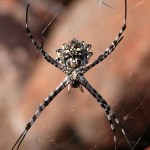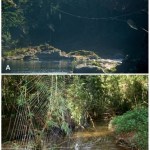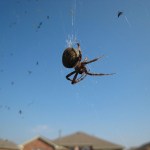spiders
Thanks for visiting!The contents of this post have been updated and moved to THIS LOCATION. Please click through. Sorry for the inconvenience!
There was some big news yesterday in transgenic silk from Notre Dame and the University of Wyoming, where scientists have genetically engineered silkworms to produce silk that is a mixture of spider silk and the regular silkworm stuff. Silkworms produce the strong and versatile silk that is used to make clothes, but spiders produce silk that can be much stronger and much more elastic. Spiders, however, don't like to be grown in huge factories and don't make easily harvested cocoons like silkworms, so gathering even small amounts is very difficult (here's a fun how-to for collecting spider…
tags: Of Venom and Silk, arachnids, spiders, new species, endangered species, NYC, New York City, AMNH, American Museum of Natural History, streaming video
Spider biologist Norman Platnick, from the American Museum of Natural History, has traveled the world cataloguing some of these creatures, many for the first time ever. World renowned for his work, he hopes to find as many as species as possible before some disappear.
Arachnids (you know, spiders and mites and things) never had much of a presence in my photo galleries. While I could chalk their absence up to an obsessive focus on formicids, the reality is that I'm mildly arachnophobic. Photographing spiders makes me squirm, so I don't do it very often.
Oddly, it really is just spiders. I don't have any trouble with opilionids, mites, or even scorpions. And it isn't all spiders, either. I'm rather fond of salticids. But there's something about the form of some spiders that touches off a deeply instinctual revulsion. Embarrassing for an…
In East Africa lives a species of spider that drinks mammalian blood. But fear not - Evarcha culicivora is an indirect vampire - it sates its thirst by preying on female mosquitoes that have previously fed on blood themselves.
Even though its habitat is full of non-biting midges called "lake flies", it can tell the difference between these insects and the blood-carrying mozzies it carries. Robert Jackson from the University of Canterbury discovered this behaviour a few years ago and one of his colleagues, Fiona Cross, has now found that the blood isn't just a meal for the spiders, it's an…
In the forests of South Africa lurks an arachnophobe's nightmare - Nephila kowaci, the largest web-spinning spider in the world. The females of this newly discovered species have bodies that are 3-4 centimetres in length (1.5 inches) and legs that are each around 7.5cm long (3 inches).
This new species is the largest of an already massive family. There are 15 species of Nephila - the golden orb weavers - and at least 10 of them have bodies that are over an inch long. Many spin webs that are over a metre in diameter.
The first of these giants was discovered by Linnaeus himself in 1767 and…
In Latin America, there lives a unique spider called Bagheera kiplingi. It's a jumping spider and it shares the group's large, acute eyes and prodigious leaping ability. But it also has a trait that singles it out among all 40,000 species of spider - it's mostly vegetarian.
Virtually all spiders are predators. They may hunt using different methods but they all end up sucking the liquidised innards of their prey. If they consume plants, they do so rarely, even accidentally. Some take the odd sip of nectar to supplement their diet of flesh. Others accidentally swallow pollen while recycling…
tags: spider silk, Madagascar, tapestry, textile art, AMNH, American Museum of Natural History, NYC, streaming video
A spectacular and extremely rare textile, woven from golden-colored silk thread produced by more than one million spiders in Madagascar is now on display at the American Museum of Natural History in the Grand Gallery.
slashdot_url="http://scienceblogs.com/grrlscientist/2009/09/unique_spider_silk_tapestry_on.php";
Drawing on the legacy of a French missionary, Jacob Paul Camboué, this contemporary textile measures 11 feet by 4 feet and took four years to make using a…
The leading spider scientists have long been flabbergasted by two things: 1) Why they aren't swimming in women with their own condominiums and 2) why some spiders seem to cover their otherwise see-through webs with junk. The scientists may now have an answer to question two, the one that, unfortunately, does not add to their genetic fitness. It appears as if spiders put leaves and other forms of organic garbage on their webs in order to fool predators into believing that the junk is in fact them, sitting in wait.
It's my web and I'll do what I damn well please with it.
A new study found on…
We think of spiders as fearsome hunters, spinners of webs and treacherous mates, but construction workers? Yes, that too. Some groups of spiders - trapdoor and wolf spiders - dig tunnels that they use to ambush passing insects. But these tunnels can also provide shelter and accommodation for other animals, including one of the rarest of Australia's lizards - the pygmy blue-tongue lizard. It seems that the lizard's survival depends entirely on the spiders.
The pygmy blue-tongue is a native of South Australia. It's so rare that zoologists thought it extinct for over 30 years and it re-emerged…
It's been just three weeks since I last wrote about the dark-footed ant-spider Myrmarachne melanotarsa, but this is one species that just keeps getting more and more interesting. To quickly recap, M.melanotarsa is a jumping spider that protects itself from predators (like other jumping spiders) by resembling an ant. Earlier this month, Ximena Nelson and Robert Jackson showed that they bolster this illusion by living in silken apartment complexes and travelling in groups, mimicking not just the bodies of ants but their social lives too.
Now Nelson and Robert are back with another side to the…
The animal world is full of harmless liars, who mimic species more dangerous than themselves in order to avoid the attention of predators. But none do it quite like the dark-footed ant-spider Myrmarachne melanotarsa.
As its name suggests, this small species of jumping spider, discovered just nine years ago, impersonates ants. In itself, that's nothing special - ants are so aggressive that many predators give them a wide berth and lots of species do well by imitating them. The list includes over 100 spiders but among them, M.melanotarsa's impression is unusually strong. It doesn't just mimic…
The courtship rituals of the spider Harpactea sadistica start innocently enough, with a dance and a hug. The male spider taps the female gently with his front legs and embraces her. But from that point onwards, things for the female go rapidly downhill. The male bites her and she becomes passive, allowing him to manoeuvre her into position. Like all spiders, his genitals are found next to his head, on a pair of appendages called the pedipalps. But unusually, his penis ends in a needle-sharp tip called an embolus.
The embolus sits at the end of a loop called the conductor. The male hooks one…
In the forests of Singapore lives a spider that must be an arachnophobe's worst nightmare. Most species are solitary hunters subdue their prey with venomous fangs, sticky silken webs or a combination of the two. But Scytodes uses a third trick - it spits a sticky, venomous fluid from its fangs that both traps its victims and poisons them (see video of related species). And it does this in packs - after hatching, spiderlings spend their early lives on their home web and they spit at, bite and devour prey en masse.
There are actually about 200 species of spitting spiders belonging to the genus…
Widow spider and harvester ants. Hallelujah Junction, California
This young black widow (Latrodectus hesperus) set up shop above the nest entrance of a colony of Pogonomyrmex harvester ants. It's an all-you-can-eat buffet, allowing the spider nearly unlimited pickings as the ants come and go.
The spider's mottled coloration is typical of young widows; they don't acquire the striking black and red warning garb until maturity.
photo details: Canon 100mm f2.8 macro lens on a Canon EOS D60
ISO 100, 1/200 sec, f/11, MT-24EX twin flash
Take that, vertebrate scum!
Incidentally, my wife used to have one of these Nephila spiders nesting in the high ceiling of her living room when she was living in Queensland. I guess she used it to dissuade potential suitors, but somehow I made it through.
Social spiders are an arachnophobe's nightmare. While the vast majority of spiders work alone, the odd few live communally and cooperate to hunt and feed. Their numbers, along with the massive webs that they all have a spinneret in creating, allow them to tackle prey far larger than themselves. The aftermath of a kill opens up new conflicts for the spiders that other cooperating hunters like lions or wolves don't share. They don't divide up the carcass to eat separately, for like all spiders, they digest their prey outside their bodies.
All the colony members spit their digestive enzymes…
There is an old joke that if Spider-Man has the powers of a spider, he really ought to be shooting webs from somewhere less salubrious than his hands. In the films and comic books, Peter Parker is empowered with the powers of a human-sized arachnid through a spider bite. He effortlessly scales walls and ceilings and shoots sticky webs from his wrists. Now, scientists have found a type of spider that does just that.
Like Spider-Man, most spiders can climb sheer surfaces and they do so with two techniques. The most obvious are small claws, called tarsi, that grip onto rough surfaces.…
Spider silk is a most amazing and versatile material, and spiders put it to all sorts of uses. It helps them to climb, to travel from place to place and most famously, to ensnare their prey. But one group of spiders, the uloborids, use their silk in a unique way - as a murderous garbage-compactor.
Most spiders kill with venom and even those that pose no threat to humans pack enough poison to deal with insect prey. Their famous webs are simply elegant traps, designed to immobilise prey so that the spider can deliver a fatal bite. But the uloborid spiders have uniquely lost their venom…
I've written two news stories in this week's New Scientist. One is on the different tactics of four-year-old boys and girls as they compete for animal puppets. The other is on the webs spun by black widow spiders. The article on the venomous, evil, little critters is longer so I'm going to use this space to talk about the black widows instead...
Black widows are notorious for both the toxicity of their venom and the cannibalistic nature of their sex, but their webs are equally interesting and less well known.
The basic design - the "sheet-based" web - consists of a well-defined horizontal…


